The History Of Volkswagen Jetta
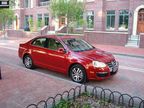
The Volkswagen Jetta is an automobile produced by German automaker Volkswagen since 1979. Depending upon the model year, country of origin, and country of sale, it is sometimes known as the Atlantic, Bora, City Jetta, Fox, GLI, Sagitar, or Vento. It is essentially the saloon / sedan version of the compact car / small family car Volkswagen Golf, and spans five generations. The Jetta name was derived from the Jet stream, following Volkswagen's long tradition of naming cars for various winds.
The Jetta body style was developed due in part to the Volkswagen marketing group's observation that the North American market leaned more towards sedans as opposed to the Golf's hatchback configuration. The new saloon variant was marketed as a more upscale car than its tailgated brethren, with nicer interior trim and a higher price. This proved to be a wise move on Volkswagen's part, as the Jetta became the best-selling European car in the United States, Canada, and Mexico. Over the years, the car has been offered in two and four-door sedan and five-door station wagon variants. As of 2005, over 6.6 million cars have been sold worldwide, with over 2.2 million alone sold in the United States. Since the original version in 1980, the car has grown in size and power with each successive generation.
The Jetta was introduced to the world at the 1979 Frankfurt Auto Show. Production of the first generation began in September 1979 at the Wolfsburg plant. In Mexico, the Mark 1 was known as the "Volkswagen Atlantic". The car was available as a two-door coupe and four-door sedan body styles, both of which shared a three box shape. Like the Golf, its angular styling was penned at ItalDesign, by Giorgetto Giugiaro. Styling differences could be found depending on the market. In most of the world, the car was available with composite headlights, while in the USA, it was only available with rectangular sealed beam lamps due to Federal Motor Vehicle Safety Standard 108. The suspension setup was identical to the Golf and consisted of a MacPherson strut setup in front and a Twist-beam rear suspension in the rear. It shared its 2.4 meter (94.5 in) wheelbase with its hatchback counterpart although overall length was up by 380 millimeters (15 in). The capacity of the luggage compartment was 377 liters (13.3 ft3), making the Jetta reasonably practical. To distinguish the car from the Golf, interiors were made more upscale in all markets. This included velour seating and color coordinated sill to sill carpeting.
Engine choices varied considerably depending on the local market. Most were based on 827 engines of the era. Choices in Spark-ignition engines ranged from a 1.1L four-cylinder engine producing 37 kilowatts (50PS) to a 1.8L I4 which made 82 kilowatts (112PS) and 150 newton metres (111ft·lbf) of torque. Some cars were equipped with Carburetors, while others were fuel injected using K or KE Jetronic supplied by Robert Bosch GmbH. Diesel engine choices included a 1.6L making 37 kilowatts (50PS) and a turbocharged version of the same engine which produced 51 kilowatts (70 PS) and 130 newton metres (96 ft·lbf) of torque.
Volkswagen briefly considered producing the Jetta in a plant located in Sterling Heights, Michigan in the USA. However, due to declining sales in North America, the decision was postponed and finally scrapped in 1982. The site was subsequently sold to Chrysler in 1983 and is still in operation as of 2007. This generation was also produced in Bosnia under the joint venture Tvornica Automobila Sarajevo (TAS) for the Balkan area.
Safety
Volkswagen was an early adopter of passive restraint systems. The first generation cars could be equipped with an "automatic" shoulder belt mounted to the door. The idea was to always have the belt buckled thereby doing away with the requirement that the driver and passenger remember to buckle up. Instead of a lap belt, the dashboard was designed with an integrated knee bar to prevent submarining underneath the shoulder belt.
In crash tests conducted by the National Highway Traffic Safety Administration, the Mark 1 received five out of five stars in a 56 km/ h (35 mph) frontal crash test for both driver and passenger protection.
Testing and review
The first generation was met with generally positive reviews. Testers found the car handled precisely, however the lack of power steering contributed to heavy steering when parking. The brakes worked well for a car of the day, but some brake fade was evident. The ride was taut but firm in the typical style of German cars, with large bumps being well absorbed by the suspension but smaller undulations coming through. Reviews differed on noise levels, some found the car fairly quiet, while others thought the engine contributed to higher noise levels. Critics found the seating comfortable, but noted that the rear seat lacked sufficient head room. Most major controls and displays such as the speedometer and climate controls were well liked, but some secondary switches were not well placed or intuitive. The aforementioned automatic seat belts in some markets that were attached to the door frame made it impossible to forget to buckle the belt, but it was difficult to enter the car with a package in hand. Writers liked that the luggage space was generous, especially for a car of its size. Additionally, numerous storage areas also gave practicality to the sedan. In one test, the car scored nearly as high as the more expensive Volkswagen Passat/ Dasher and the Audi 80/ 4000.
The Volkswagen Atlantic was introduced in the Mexican market in February 1981. The sole competition for the Atlantic in the Mexican market was the Renault 18. The Mark I continued to be manufactured and marketed in South Africa after the introduction of the Mark II, badged as the "Fox".
The Mark 2 series is the longest running Jetta so far. Introduced to Europe in 1984 and to North America in 1985, the second generation Jetta proved to be a sales success for Volkswagen. The car secured the title of best-selling European car in North America, and outsold the similar Golf by two-to-one in that market. Based on the all new second generation Golf platform, the car was larger, heavier, and could seat five people instead of four as in the Mark 1. Exterior dimensions increased in all directions. Overall length was up by 100 millimeters (3.9 in), the wheelbase grew 66 millimeters (2.6 in), and the width went up 53 millimeters (2.1 in). The suspension setup was basically unchanged from the first generation, although refined slightly. Aerodynamics improved considerably, with a drag coefficient of 0.36. With a 470 liter (16.6 ft3) luggage compartment, the trunk had grown nearly as large as some full sized American sedans. Interior room was also increased 14%, which changed the EPA class from sub-compact to compact.
Cars built in Germany were assembled in a brand new (at the time) plant at Wolfsburg in Assembly Hall 54. The plant was heavily robotized in an effort to make build quality more consistent. New innovations on the second generation included an optional Trip computer (sometimes referred to as the MFA) as well as silicone dampened engine and transmission mounts to reduce Noise, Vibration, and Harshness levels. In 1988, a more advanced fully electronic fuel injection system became available. This arrangement is known as the Digifant Engine Management system.
Like the Mark 1, the second generation was offered as a two-door coupé or four-door sedan. External changes throughout the series' run were few: the front-quarter windows were eliminated in 1988 (along with a grille and door trim change), and larger body-colored bumpers and lower side skirts were added from 1990.
In 2007, Volkswagen of America held a contest to find the diesel powered VW with the highest distance traveled on the original engine. The winning car was a 1986 Jetta Turbodiesel found in Blue Rock, Ohio, and had 562,000 miles (904,000 km). A local dealer verified the odometer reading. Notable on this particular car was that it also had the original muffler despite being located in an area subject to road salt in the winter.
Safety
In a crash test conducted by the National Highway Traffic Safety Administration, the Jetta received three out of five stars for both driver and passenger protection in a 56 km/ h (35 mph) frontal crash test. The Highway Loss Data Institute (part of the Insurance Institute for Highway Safety) found the injury and collision losses for the Jetta to be among the best of the small 4 door sedan category. It was topped only by the Golf. Earlier models had the dubious distinction of having an especially high rate of radio theft. Apparently, the mounting of the radio made it especially easy to remove quickly. To correct the problem, VW introduced a theft protection system to all cars. When the power supply to the radio was removed, it automatically went into "safe" mode. When plugged back in, it would not work unless a secret code was entered. This made it essentially useless to thieves, although provided a hassle to customers who misplaced their code card.
Testing and review
The car received generally positive reviews, with critics praising the car's excellent handling, as well as a roomier interior compared to the last generation. Stiff shifting manual transmissions were a downside, and braking worked reasonably well although some brake fade was evident in the lower trim lines equipped with solid discs in front and drums in back. A number of reviews noted that the ride was stiff and busy, even though it did have good control typical of German cars. Despite additional sound insulation, road noise was evident especially on coarse pavement. In top sport trim (sometimes called the GLI or GTX), some reviewers noted the car was a less expensive alternative to a BMW or Audi. The sport trim added larger wheels, a stiffer suspension, and closer ratios on the manual transmission. Later models of the Mark II GLI had a 16 valve dual cam engine, originally a 1.8 litre engine and beginning in 1990 with the newer Mark II body style an upgrade to a 2.0 litre 16 valve.
Worldwide production
Besides the VW production base in Germany, this generation was produced in a number of foreign countries, including China, Nigeria, Mexico, South Africa, USA, and the former Yugoslavia. The Mark 2 Jetta went on to become the first Volkswagen model produced in China by Volkswagen's second joint venture partner First Auto Works. Production began on 5 December 1991. Initially sold as Complete knock down kits, local manufacturing has gradually taken over in the form of Semi-Knocked Down kits in 1992, and full local production in 1995.
The car has had two revisions since its inception in China, the first facelift borrowed spare grilles left around from the fourth generation Volkswagen Passat in 1997. Production started in August 1998 and its name was changed to the Jetta King. The second facelift was revealed in March 2004 (taking influences from Volkswagen's most expensive model, the Phaeton. On 29 July 2007, it was announced that First Automotive Works expanded its production of the Mark 2 Jetta by building a new assembly plant in Chengdu, Sichuan Provence in Southwest China. The expansion is driven by the high demand for the car, a desire to expand in the western part of the country, as well as the long term goal of FAW to develop new derivatives from the car's platform independently of Volkswagen.
For the 3rd generation Jetta, the Jetta name was dropped, and it was officially named the Volkswagen Vento in Germany, and all other European countries. Again, following the precedent of naming cars for winds, the "Vento" (as it was known in most of the world) debuted in 1992 while the JettaIII debuted in North America in 1993 after production delays and quality problems at the Volkswagen plant in Puebla, Mexico. The name Vento means wind in both Portuguese and Italian. Because of the success of the second generation in North America, VW decided to keep the Jetta nameplate. However, in Europe the car was given its new name to appeal to a younger market.
Styling was penned by a design team led by Herbert Schafer, and again the car became more aerodynamic than the previous generation. Although visually similar to the Mark 2, there were many refinements underneath. Aerodynamics were improved, with the car now having a drag coefficient of 0.32. This included a new structure which now met worldwide crash standards. Suspensions were an evolutionary rather than revolutionary refinement of the setup on previous editions. In addition, the car became more environmentally friendly with the use of recycled plastics, CFC-free Air Conditioning systems, and paint that didn't contain heavy metals.
This generation of the car is widely credited for keeping VW from pulling out of the North American market. At the time of its introduction in 1993, Volkswagen of America's sales hit a low not seen since the 1950s. The division sold only 43,902 cars in that year. Sales began slowly due to the aforementioned issues at the Puebla plant. However, sales rebounded dramatically in the following years, mostly based on the strength of the Jetta, which continued to be the best selling VW in the USA.
Safety
When equipped with dual air bags, the Mark 3 received three out of five stars in a 56 km/ h (35 mph) frontal crash test carried out by the National Highway Traffic Safety Administration. In a 64 km/ h (40 mph) frontal offset crash test conducted by the Insurance Institute for Highway Safety, the car received a score of "Marginal".
Testing and review
Newly available on the third generation was Volkswagen's 1.9L TDI (Turbo Direct Injection) 67kilowatt (90hp) diesel engine. Fuel economy was a strong point with ratings of 5.7 L/ 100 km (41 mpg [US]) urban cycle and 4.8 L/ 100 km (49 mpg [US]) extra urban. In top trim lines, the 2.8L VR6 SOHC six-cylinder engine was available. In one car magazine's test, the 128kilowatt (172hp) power plant was able to accelerate the car from 0 to 97km/ h (60mph) in 6.9 seconds.
Reviews were generally positive with testers praising the crisp handling and comfortable ride as well as a greater level of refinement compared with the previous generation. However, some reviews noted that the more sporty suspension tuning found in some trims made the car bouncy, especially on the expressway. The manual transmission shifted crisply, however the automatic transmission reduced acceleration noticeably. Some critics complained that the controls had some quirks, including a cryptic windshield wiper control. If equipped, power window controls had the unusual arrangement of the front buttons located on the door, while the rear buttons were located on the center console. As with previous generations, the luggage compartment provided generous space. However, unlike previous cars, the rear seat was able to fold forward in order to expand luggage space further. In earlier build cars, the glove compartment was deleted if the car was equipped with dual air bags. There were also some complaints about the lack of cup holders in the earlier cars, as well as the lack of a safety interlock which would require the driver to press the clutch pedal prior to starting the car.
Specifications
Petrol engines
Diesel engines
Production of the fourth generation car began in July 1998. Carrying on the wind nomenclature, the car was known as the Bora in much of the world. Bora is a winter wind which blows intermittently over the coast of the Adriatic Sea as well as in parts of Greece, Russia, Turkey and in the Sliven region of Bulgaria. In North America and South Africa, the Jetta moniker was again kept on due to the continued popularity of the car in that market.
The Mk4 debuted shortly after its larger sibling, the Passat, with which it shared many styling cues. The rounded shape and arched roofline served as the new Volkswagen styling trademark, abandoning traditional sharp creases for more curved corners. The car was also offered as a station wagon. New on this generation were some advanced options such as rain sensor controlled windshield wipers and automatic climate control.
Although slightly shorter overall than the Mark 3, the fourth generation saw the wheelbase extended slightly. Some powertrain options were carried over. Nevertheless, two new engines were offered, the 1.8 liter turbo 4-cylinder (often referred to as the 1.8T), and the VR5 (a 5-cylinder derivative of the VR6 engine). The suspension setup remained much as before. However, it was softened considerably in most models to give a comfortable ride, which was met with some criticism.
In 2004, a new line of "Pumpe-Düse" diesel engines were offered. This new design employed advanced unit injectors and additional electronics and emissions equipment to meet new air emissions standards in Europe and North America, and is considerably more complex than the older diesel engines previously offered. To accomplish the task of producing sufficient power while meeting emissions standards, the "PD" technology injects fuel into the combustion chamber at pressures up to an incredibly high 2,050bar (30,000psi). The purpose of the high pressure is to promote fine atomisation of the fuel which supports more complete combustion. To reduce noise, the engine employs a "pilot injection" system which injects a small amount of fuel prior to the main injection. All of the new generation of diesel engines require a special motor oil that meets Volkswagen oil specification 505.01. Serious engine damage will result if oil not meeting this standard is used.
Safety
Safety on the fourth generation cars was a high priority for Volkswagen. The car was built using such advanced processes as highly mechanized presses, improved measuring techniques, and laser welding of the roof. In crash tests, the fourth generation car received very good marks. In the New Car Assessment Program tests conducted by the National Highway Traffic Safety Administration, the car received five out of five stars for both driver and passenger protection in a 56 km/ h (35 mph) frontal impact. New side impact tests at 62 km/ h (38.5 mph) awarded the car four out of five stars for both driver and rear seat passenger protection. In the more severe 64 km/ h (40 mph) offset test conducted by the Insurance Institute for Highway Safety, the Mark 4 was awarded the highest score of "Good". Injury, Collision, and theft losses were low for a car of its class.
Testing and review
Critics usually found the fourth generation to their liking. The car was praised for its sure-footed handling as well as a comfortable ride. Other reviewers noted the car to be an attractive but somewhat expensive choice in the compact car segment. However, some complaints were made that the back seat lacked adequate room for two adults. Also, some found the cushion was too firm. The interior of the car was universally praised for the high level of fit, finish, and materials quality. Critics noted it was reminiscent of much more expensive cars. New in this generation was VW's signature blue and red instrument lighting which became standard across the lineup in 1999. The placement of the climate controls low on the console was also met with some criticism. Flimsy cupholders were placed directly above the stereo, thus obscuring vision of the stereo LCD. However, this problem was rectified on later mark 4 models.
The earlier models have a few quality control issues, as a number of owners reported windows falling into the doors, electrical problems, and emissions system defects. The fourth generation takes approximately 52 hours per vehicle to assemble in the Puebla factory. In contrast, General Motors Spring Hill Assembly Plant took only approximately 18 hours to build a Saturn Ion, a car similar in size to the Mark 4.
Station wagon
Volkswagen introduced a station wagon version of the fourth generation car in January 2001 at the Los Angeles Auto Show. This was the first time an "A" platform VW was available in North America with that body style. Although the sedan was built in a number of locations, all Jetta Wagon models were built in the Wolfsburg plant. In back, 963 liters (34 ft3) of space was available in the cargo compartment. When the rear seats were folded, the car could hold 1473 liters (52 ft3). Like the sedan, the station wagon received high marks from most reviewers. They noted that the cargo area was large and useful. Additionally, the interior kept its top quality fit and finish, although the rear seat was still a bit small. In Europe, the station wagon was sometimes sold as part of the Golf line either in addition to or instead of the Bora. Other than different front bumpers, fenders, headlights, and hood, the cars were identical.
Ongoing production
As of 2008, the fourth generation car is still sold in addition to the newer Mark 5 due to higher pricing of the fifth generation in some countries such as Mexico, China, Canada, Brazil and Argentina. Like its second generation predecessor, the Mark 4 continues to be marketed in China by Volkswagen's joint venture partner First Automotive Works-Volkswagen China.
In China, the car received a facelift in the summer of 2006, with a Passat Mark 5.5 lookalike face. A hatchback version (i.e. the Golf) is also produced, but is badged as the Bora HS. The model available in Mexico, Canada, Brazil and Argentina for 2008 was likewise facelifted with the same design found in China.
In October 2006, Volkswagen re-released the fourth generation car in Canada (for the 2007 model year) as the City Jetta. The move was made to allow Volkswagen to be more competitive with the rest of the compact class as the fifth generation Jetta had moved upscale versus much of the competition. The only engine available is the 2.0L SOHC 86 kilowatt (115hp) gasoline four cylinder. The City Jetta is built alongside the fifth generation in the Puebla Assembly Plant.
The Chinese model will receive further modifications for 2009, and it will be marketed as the Bora Classic to make way for the Sagitar.
The fifth generation debuted at the Los Angeles Auto Show on January 5, 2005. It was only the second Volkswagen product to make its world debut at a U.S. Auto show (the other being the New Beetle). Additionally, the Mark 5 went on sale in the USA prior to any other country, reflecting the importance of the car in that market for VW. US$800million was spent upgrading the factory in Puebla for its production. This included a US$290 million new engine production line for the 5 cylinder power plant, a US$50 million investment in the press shop, as well as a US$200 million purchase of 460 robots, which increased automation by 80%.
Although produced in the largest volumes in Mexico, final assembly of the car also takes place in China and South Africa for those respective markets. Like initial production of the second generation in China, the Asian and African plants build the car from a complete knock-down (CKD) kit shipped from the factory in Puebla. Local assembly in Kaluga, Russia started in late 2007. The plant will be producing Volkswagen Passat and Skoda Octavia cars during 2008. Production began in India in 2008. Currently, the Skoda factory in Aurangabad is used for final assembly. As with the previously mentioned assembly plants, CKD kits from Volkswagen de México will be used.
The fifth generation car has the widest variety of names of any generation. In most countries, it is referred to as the Jetta. Exceptions to this include "Bora" in Mexico and Colombia, "Vento" in Argentina and Chile, and "Sagitar" in China. The Mark 5 is 170 millimeters (6.7 in) longer, 30 millimeters (1.2 in) wider, and has a 70 millimeter (2.8 in) longer wheelbase than the previous iteration. Interior room has increased from 2.46 cubic meters (87 ft3) to 2.58 cubic meters (91 ft3). In particular, rear legroom was increased by 65 millimeters (2.6 in) over the fourth generation. Luggage compartment volume is up to 453 liters (16 ft3). One major change is the introduction of the first multi-link independent rear suspension in a Jetta. The design of the rear suspension is nearly identical to the one found in the Ford Focus. VW reportedly hired engineers from Ford who designed the suspension on the Focus.
Styling reflects a new direction for the Volkswagen brand, with a new chrome front grille which has spread to other models. Some critics appreciated the new styling, whilst others dismissed it as too bland looking compared to the 4th generation.
Features
The body of the fifth generation uses extensive high strength steel, and use of laser welding is up from 5% to 35% of body parts. This results in double digit increases in both dynamic and torsional rigidity. Other body innovations include an impact-absorbing front bumper which yields slightly in the event of a collision with a pedestrian, reducing the chance of injury. A new door design allows just the outer panel to be removed and replaced if damaged, rather than the entire door. Safety was again enhanced with many active and passive features available or standard. These included Side Curtain Protection, rear side airbags, new generation Electronic Stability Program with Anti-Slip Regulation and Brake assist, as well as active head restraints. A DSG transmission, available dual-zone automatic climate control, and electro-mechanical steering are also new innovations.
The fifth generation car has a totally redesigned electrical system. Control modules are used for everything from the radio to the Drivetrain, transmitting over Controller Area Network (CAN) buses. Transmission of signals is done digitally at 500 kilobits per second, which reduces the number of wires needed and thus reduces the chance for faults. Cars equipped with halogen headlamps have a VW logo integrated into the reflector. In most of the world, the taillights use LED bulbs. However, in North American specification cars, standard bulbs with a different design are used.
The engines that are available depend on the location. In Europe, a range of the new generation FSI engines are available. Additionally in that market, the car can be had with an engine known as the TSI. This engine combines turbo and supercharging to make a small but powerful engine with low fuel consumption. The Jetta available in the Americas and the Middle East, is powered by a 2.5 liter 5-cylinder 20 Valve engine in most trims. This engine shares its head design with the V10 engine found in the Lamborghini Gallardo.
In North America, the diesel TDI engine was not offered in 5 U.S. states when the Mark 5 Jetta was introduced, due to the tight emission standards promulgated by the California Air Resources Board. The four other states involved opted to adopt the more stringent California standards. Where it was available, it fell into the least-restrictive emission category. That category was removed in 2007, prompting the diesel Jetta to be unavailable in that market for about a year until the introduction of a new common rail diesel engine, which appeared in August 2008. The introduction was delayed for approximately 6 months due to technical issues with the new emissions control system. The TDI Clean Diesel engine is rated 140 hp, and uses advanced features such as a diesel particulate filter to reduce NOx and particulate emissions in order to qualify as a Tier II Bin 5 vehicle (equivalent to California's LEV II rating), therefore allowing it to be sold in all 50 U.S. states. AdBlue (urea injection) will not be used initially, reducing maintenance requirements.
The Mark 5 has a number of quirks which may confuse owners who are unfamiliar with the car and have not read the owners manual. For example, to replace the windscreen wipers, the wiper lever must be pressed down within 10 seconds of turning off the car to activate the "Service/ Winter Position" mode. Additionally, the wipers change their parked position slightly every few trips to reduce wear, sometimes causing unneeded concern on the part of the customer. Upon a cold start, the engine is noisier than normal for approximately 30 seconds due to the operation of the Secondary Air Injection Pump, causing alarm in some instances. This feature is designed to reduce emissions by adding fresh air (which contains more oxygen than the air that has been through the engine) into the exhaust stream. Some owners have been surprised that synthetic oil must always be used when changing the oil. Volkswagen has developed a strict motor oil quality standard to prevent oil sludge problems, and oil meeting this standard must be used to ensure full warranty coverage.
Safety
The car received high ratings in crash tests from the Insurance Institute for Highway Safety. The car received an overall "Good" rating in both front offset and side impact tests. In the side impact test the Jetta receives "Good" marks in all nine measured categories. In 2005 the Institute noted that the side impact protection performance was the best they had ever rated. In 2006, the car received a "Top Safety Pick" award from the Institute. The National Highway Traffic Safety Administration gave the fifth generation car four out of five stars for both driver and passenger protection in a frontal impact, while the car received five out of five stars in a side impact crash test. To tout the safety of the car, a series of television commercials with the tag line "Safe happens" showed the car being involved in a collision whilst afterward the occupants are shown to have emerged unscathed.
Testing and review
The fifth generation has received generally positive reviews. Nevertheless, some critics have complained that the car lost some of its distinctive European character with the redesign. Most reviewers found the ride to be firm and well controlled, but not always as forgiving as the previous generation. Handling was a strong point, with quick and precise steering and minimal body roll. Fit and finish received excellent marks, with reviewers noting the car felt very upscale. The front seats were firm but well liked, and the rear seat was roomy, in contrast to the cramped quarters in the fourth generation. Controls and displays were generally good.
Reviewers were particularly impressed with the "Sportline" models (known as the GLI in North America). Equipped with sport seats, a firmer suspension lowered by 15 millimeters, and low profile tires, critics praised the excellent handling that was an improvement over the already good performance on the standard model. Additionally, the 2.0 Turbo FSI engine also won commendation for its high power figures, smooth operation, and low fuel consumption. Along with its hatchback brethren, the fifth generation ranks among the top cars on the market in independent reviews of resale value.
Although improved over the fourth generation, the Mark 5 still takes over 42 hours to assemble at the factory in Mexico. Part of this disparity is blamed on the switch to the more complex independent rear suspension. Volkswagen has publicly stated its discontent over the excessive assembly time and pledged to streamline manufacturing in the next generation of A platform cars. In the interim, Volkswagen de México is making a concerted effort to further increase productivity at the plant by consulting outside experts from Toyota and other Japanese companies. By implementing many lean manufacturing principles and techniques, a goal has been set to increase productivity levels at the factory by 30% or more in the coming years.
SportWagen
At the 2007 New York International Auto Show, Volkswagen unveiled a station wagon version dubbed the "Jetta SportWagen". The Jetta wagon was not sold for the 2006, 2007 & 2008 model years.
The new wagon has 930 liters (32.8 ft3) of cargo space with the rear seats upright, or 1894 liters (66.9 ft3) with the seats folded. One unique option is a panoramic sunroof. The available roof is a full 1.18 square meters (12.7 ft2) in area, giving both front and rear seat passengers an expansive view of the sky.
The vehicle is sold as the Golf Variant in most markets outside the United States. In Mexico it is sold as Bora SportWagen, Jetta Variant in Brazil, Vento Variant in Argentina, Jetta Wagon in Canada.
In the early 1980s, VW released a limited production electric Jetta called the Jetta CitySTROMER. It featured a 24.8HP (18.5kW) drivetrain (later 37.5HP (28kW)), with a range of 190km (250 in the later version).
Volkswagen released a Jetta MultiFuel Jetta in 1991, at first to the governments of the state of California and New York, and then for limited retail sale in those states to the public. They are an early example of an E85 vehicle, burning alcohol and methanol, in combination with gasoline. These Jettas can still be found roaming the streets.
In 2001, at the 18th International Electric Vehicle Symposium and Exhibition in Berlin, VW released two environmentally friendly cars: the Bora HyMotion and the Bora Electric.
The Bora HyMotion was a hydrogen powered Mark 4 with a 75kW fuel cell that could accelerate from 0 to 97 km/ h (60mph) in 12.5 seconds. With a 49 liter tank of cryogenically stored hydrogen, it had a range of 350km (220mi). Top speed was 140 km/ h (87 mph).
The second concept vehicle was called the Bora Electric. It had a power rating that varied according to the operating conditions. The Bora Electric could accelerate from 0 to 100km/ h in 10 seconds with a range of 160km. The energy needed to drive the vehicle is stored in a Lithium-ion battery. It was noted that its chance of success was limited in the marketplace given the high cost of the electric drive system.
In 2002, Volkswagen along with Paul Scherrer Institute released another hydrogen powered car called the Bora Hy.Power. The car was powered by hydrogen compressed to a pressure of 320bar (4600psi). It had ratings very similar to the HyMotion; with a 75kW (100hp) power source. A special feature of the car was a 60 kilowatt super capacitor which could boost power when needed and also recover energy when coasting.
Volkswagen has considered producing a mild hybrid version of the fifth generation mainly for the North American market. However, no official plans have been promulgated, and the company will continue its clean diesel push regardless of the decision regarding hybrid technology.
Biofuels
Volkswagen approves fueling Jetta TDIs with up to 5% biodiesel (B5). The diesel engine can sometimes be run with higher percentages of biodiesel, particularly during warm months. However, if the car experiences a fault, Volkswagen will deny warranty coverage if unapproved fuel is used.[citation needed]
Some owners have converted their diesel cars to run on vegetable oil used as fuel. This can be obtained from most fast food restaurants for a minimal fee (if any). However, there has been at least one report of catastrophic engine damage resulting from the use of waste vegetable oil. Running the car on biofuels of any type has the advantage of being at least partly carbon neutral.
VW also released a Bora TDI which was powered by SunFuel, a synthetic fuel developed in partnership with Royal Dutch Shell. The company also displayed Bora TDI powered by SunDiesel that VW also developed with DaimlerChrysler along with Choren Industries.
From Wikipedia, the free encyclopedia
More About Volkswagen Jetta
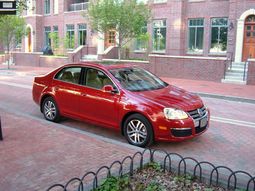
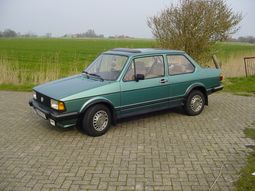
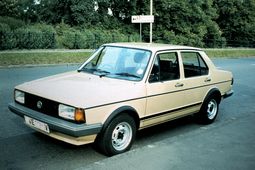
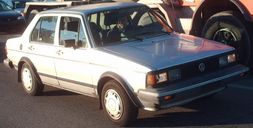
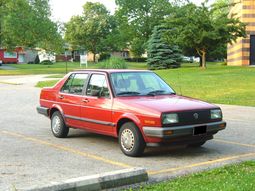
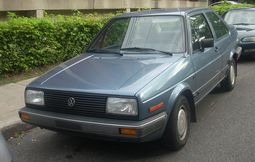
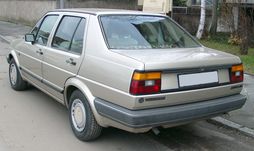
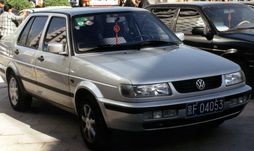
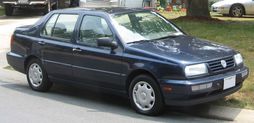
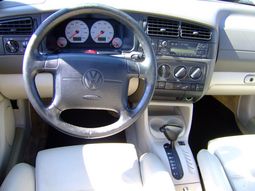
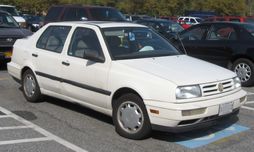
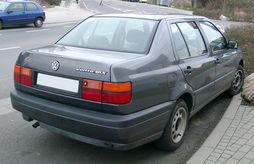

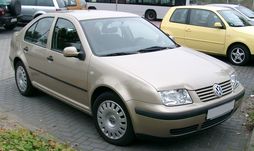
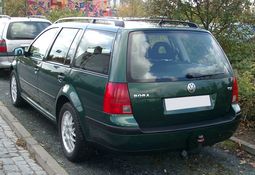
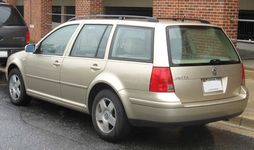
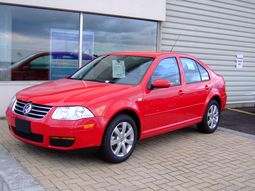
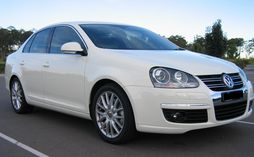
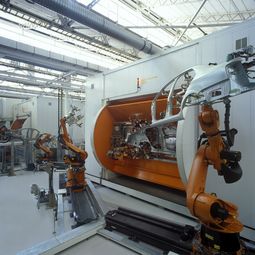
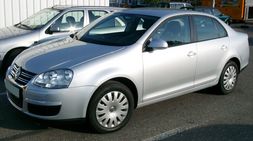
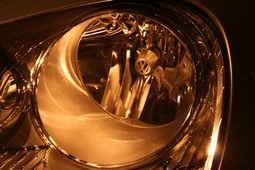
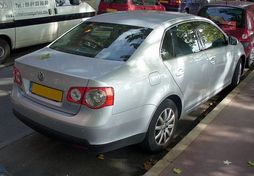
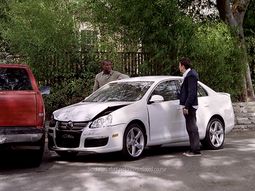
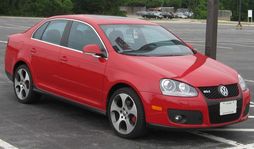
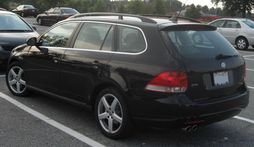
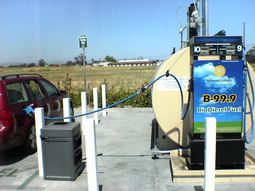
|